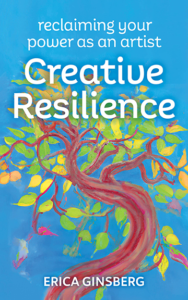
This post was written by Erica Ginsberg, a Senior Program Officer at Meridian, working with the International Visitor Leadership Program. This excerpt is from Ginsberg’s book “Creative Resilience,” available for purchase here.
“Creative Resilience” looks at the ups and downs of the creative process. Creative pursuits—whether a paid profession, a side hustle, or a leisure activity—can bring joy and meaning to the lives of artists and audiences. But they also bring challenges of motivation, confidence, blocks, and the realities of rejection. The book provides guidance for anyone navigating these challenges from those who have been there. It includes relatable real-world examples from creatives across disciplines, ages, and stages of their careers, including dancers, musicians, writers, painters, and filmmakers, as well as the author herself who has been both an artist and an arts administrator. This is an excerpt from a chapter about what motivates artists to create in the first place.
When we think of creativity, we often associate it with that inner spark, what psychologists call intrinsic motivation. We create because we enjoy the challenge, the process, the outcome, or some combination of the three.
It can be tempting to say that intrinsic motivators are superior to extrinsic motivators when it comes to our creative process. Indeed, without that inner spark, it would be challenging to move forward with our work. However, extrinsic motivators are no less important. Inventors are often driven by the reality that they are not alone in their pursuits of discovery—or patents. Artists may apply for grants and labs and showcase opportunities specifically to give themselves the structure and deadlines that keep them moving forward. Performing artists, in particular, draw energy from the audience that feeds back into their performance. Those who make, or want to make, a living from their creative work know the market may impact some of their output.
Some of these motivating forces overlap with how we view success. Anyone who is seeking to get their art into some kind of public setting—such as a gallery, a concert, a film festival, or a published book—is motivated not only by an intrinsic love of what they are making, but also may desire acceptance by gatekeepers, award-makers, influencers, critics, and audiences that they want to experience and be moved by their work.
We may lose ourselves in the process if we focus only on the extrinsic factors of the marketplace. Ignoring those extrinsic factors, however, can be just as detrimental.
Not all extrinsic motivators are based on measurable outcomes such as positive reviews, purchased artwork, or awards on the shelf. Some motivators can blur the lines between the intrinsic and extrinsic. Let’s take spite, a motivating factor that is highly underappreciated, as an example.
Since a lot of what I do in this book is to help positively reframe the traits, emotions, or experiences that are commonly thought of as negative, I want to focus on spite because it can be a key motivating force for many creative people, whether they admit it or not.
I don’t mean “spite” in the traditional way we think about it, as a desire to be malicious towards someone—I don’t intend to encourage ill will toward other people. However, many artists have had what we can refer to as inciting (or, shall we say, inspiting) incidents where they have encountered others who have doubted, disregarded, or even outright demeaned their artistic work or goals.
For Cynthia Paniagua, her work fusing traditional and contemporary dance brought out complexities that reflected her own mix of identities—as a woman, a child of immigrants, a Latina, an Andina, a New Yorker, a Peruvian-American, a Nuyorican.
“I’ve always been careful not to step on anybody else’s toes. It’s very rare to fuse contemporary and folkloric expressions in Peru. I want to make sure that every dance step is connected to a meaning that is researched, that I’ve gotten permission from the community to use this step in this choreography. I have done all that out of respect for the community, but you’re still going to have a hater in the back saying, ‘There’s a gringa. Who does she think she is putting that together? She’s not really Peruvian. She’s Puerto Rican. She’s born in New York. These gringos think they could do anything with our stuff.’”
At the same time, Cynthia’s research work was challenging because there were few source materials she could draw from beyond the work of anthropologists who were not dancers.
“I would feel intimidated by that, as though my work was not valid because I didn’t have anybody else who’d really done this kind of work in the past. There were no renowned anthropologists who could say this is right. I pulled from every angle, but academia is about finding the proof. You have to have some old dude who wrote it to validate, right? There’s always something that let me know that I didn’t belong one hundred percent and I would have to fight my way to share the message.”
This was where intrinsic motivation met extrinsic motivation. Cynthia already had the spark of her calling. Yet she also felt pushed to work harder because of those who would question her work. Whether the naysayers intended to be extrinsic motivators, they nevertheless had a hand in the process.
It is not uncommon for artists who are just starting to think of rejection or criticism as an obstacle or wall that must be traversed. This is particularly the case if it comes from within one’s own family. As the actress Cicely Tyson reflected on her own path to acting, “When I told my mother that I wanted to be an actress, she said, ‘You can’t live here and do that,’ and so I moved out. I was determined to prove her wrong because she was so sure that I was going to go astray. And that’s the juice that kept me going.”
That’s the juice that keeps many artists going. They may have to keep drinking that juice to keep going even as they evolve as artists. Claudia DeMonte faced this midway through her career when she set out to curate a traveling art exhibit called Women of the World. While she had always made women’s experiences central to her own visual art and was an avid world traveler, Claudia had a vision to combine these passions by asking women artists from almost every country to create artworks that they saw represented women. Keep in mind this was prior to mainstream use of email or the internet. When Claudia contacted a renowned art curator to ask for his advice on how to go about connecting with artists in sub-Saharan Africa, she was surprised by the lack of encouragement. “You’re never going to be able to do this project; I guarantee you,” was the response she received. “I was so depressed when I got off the phone,” said Claudia, “He was the African art scholar. If he can’t help, who can?” She also wrote to the cultural attachés at the United Nations but received little in the way of encouragement or responses.
In spite of this lack of enthusiasm from potential supporters, Claudia moved ahead with the project. “I still needed to do it. I kept going. I got really determined.” In the end, she secured works from 177 countries. Her work has been exhibited in more than twenty museums and art centers around the world and is in the permanent collection of the International Museum of Women, an online museum that covers women’s issues worldwide. Proving the doubters wrong can be a powerful motivator, and certainly was for Claudia.
No matter the creative discipline, artists need to develop a thick skin. Even in disciplines that are collegial and collaborative, there is also much competition. For patrons. For grants. For sales. For critical acclaim. As an artist, you will face far more rejection than acceptance. Worse, you will often face silence. You may have poured your heart and soul into your creative work only to have it ignored. That can take an emotional toll, leading to bitterness, cynicism, and apathy.
Allowing negative feelings to pervade the entire process would essentially be relinquishing control to extrinsic forces and could be an obstacle to creativity and growth. An external motivator may have jump-started the project, but intrinsic motivations had to carry it. While spite can be a kind of spark that starts the fire, it will not sustain the flame itself. To do your best creative work is to sustain the fire that comes from within.
To read the full book, you can purchase Creative Resilience on Amazon and other booksellers.


















